Chinatown has always had a rough go of it. Born of the forced displacement of an entire community, the neighborhood has often been caught in fights between warring interests. Currently, that is taking the form of the intensely personal and ongoing struggles over displacement and gentrification that have affected the neighborhood, making it the site of some of the most visible battles over gentrification in Los Angeles in recent years.
On one side of the neighborhood is the heroic struggle of the Hillside Villa tenants, while on the other has been the fight over a proposed development across from Chinatown Station. Lately, the big fight has been over the impact of a proposed gondola to Dodger Stadium. Prior to the pandemic, the neighborhood was becoming a foodie destination even while its last full-service grocery store was shutting its doors. The traditionally working-class and elderly community of Chinatown is increasingly finding itself in conflict with an influx of young professionals, making the future of the neighborhood fraught indeed.
All of this is to say, Chinatown needs our love and attention more than ever now. The Los Angeles Public Library offers a wonderful online exhibit about the history of the neighborhood. Here, we’ve put together a walking tour of what Chinatown has to offer, focusing on the legacy businesses and community landmarks that have endured.
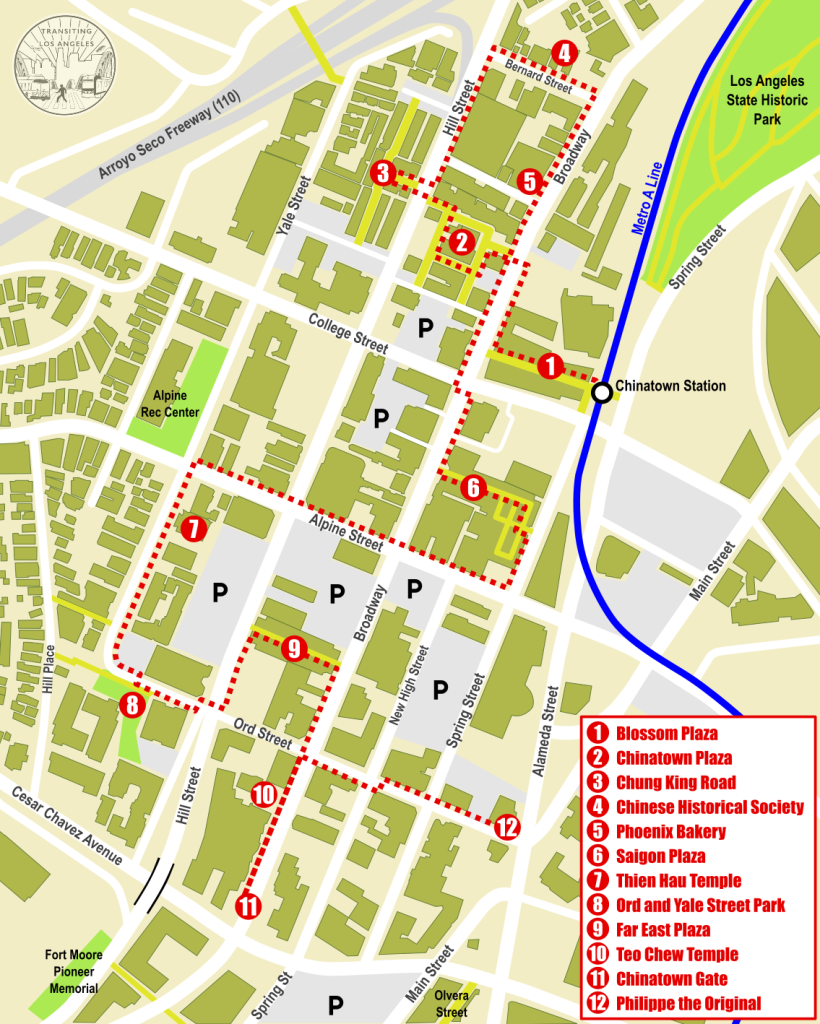
There are plenty of Metro buses travelling along Hill and Broadway through the neighborhood, and along Cesar Chavez on the southern edge of Chinatown, but we’ll start our tour at the Chinatown Station on the A Line (formerly the Gold Line), which puts you right in the middle of everything.
Note that places in Chinatown tend to close early. After dark, the only places that tend to remain open are certain restaurants (and even those are usually closed by 9 or 10pm). Nighttime does offer the opportunity to view the gorgeous neon around Chinatown, but a lot of the stuff on this tour, particularly the shops, are only open during the day.
1: Chinatown Station/Blossom Plaza
The elevated platform of Chinatown Station offers a good vantage point over the neighborhood, looking across to the Downtown skyline. To the north, you can see the tracks curve around Los Angeles State Historic Park, which we covered in a previous post. Just a block to the south, the tracks run past the headquarters of Homeboy Industries, a local non-profit that provides job training and support to former gang members. One of their enterprises is the Homegirl Cafe, which is hands-down our favorite place in the neighborhood to grab a cup of coffee, and their food is fantastic as well.
To the west, you can see the entryway from the station to Chinatown: the passageway through Blossom Plaza, one of the newer developments surrounding the station. Of all the newer buildings in Chinatown, Blossom Plaza has to be the most friendly and public-facing, even if it still suffers from a little of the sterility that plagues any new development. It is beautifully lit at night, with a little rock feature with steam coming out of it in the plaza facing the station. Just to the north, the historic Capitol Milling Co. building—the oldest industrial building still standing in Los Angeles—has just finished an extensive renovation, although it remains closed to the public.
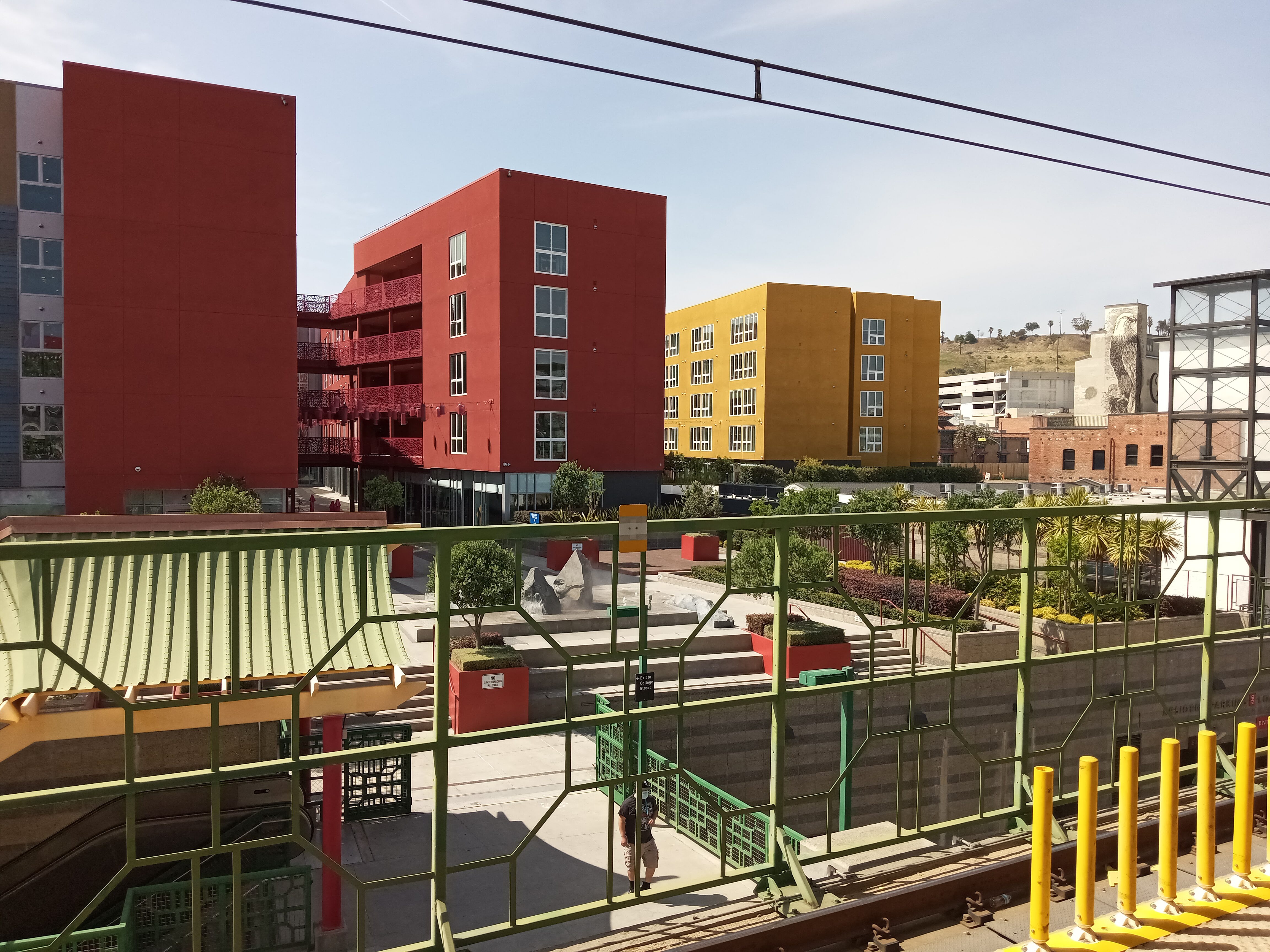


Walk on through Blossom Plaza, where you’ll pass a café, a ceramics studio, and a pretty decent art gallery called Eastern Projects. When you reach Broadway, make a right. After about a block you’ll be standing right across the street from the elaborate gateway to the most famous landmark in Chinatown.
2: Chinatown Central Plaza
From the 1870s to the 1930s, the city’s original Chinese enclave was located just to the south along Alameda, where Union Station is located today. Civic leaders of the time were very open in their disdain for the neighborhood, painting it as a den of vice and corruption. With no plan to relocate the Chinese community, most of the neighborhood was razed to make way for the train station, and what little was left was demolished to make way for the 101 freeway in the 1940s. Today, the Garnier Building in the El Pueblo district, now home to the Chinese American Museum, is the only surviving remnant of Old Chinatown.
“New Chinatown,” as Chinatown Central Plaza was referred to when it was completed in 1938, was a first-of-its-kind development. With Chinese-Americans excluded from purchasing property in most of the country, Chinatown Central Plaza was the first planned Chinatown in the nation to be owned by Chinese-Americans. Housing and offices occupied the floors above storefronts, with modern amenities and designed in a mixture of Chinese and American architecture: pagodas, overhanging tile roofs, intricate woodwork, hanging lanterns, and colorful neon adorning the rooflines. It was a romanticized vision of Chinese culture, and when it opened it proved very successful at drawing tourists.


Over the years, the foot traffic has definitely declined. Chinese American culture grew past the need for romanticized Chinatowns. Nowadays, the suburbs of the San Gabriel Valley are widely regarded as the heart of the city’s Chinese American community, while the novelty of Chinatown has worn off for most tourists. Nevertheless, Chinatown Central Plaza remains a beloved landmark, the hanging lanterns bobbing in the breeze during the day and the buildings aglow in soft neon at night.
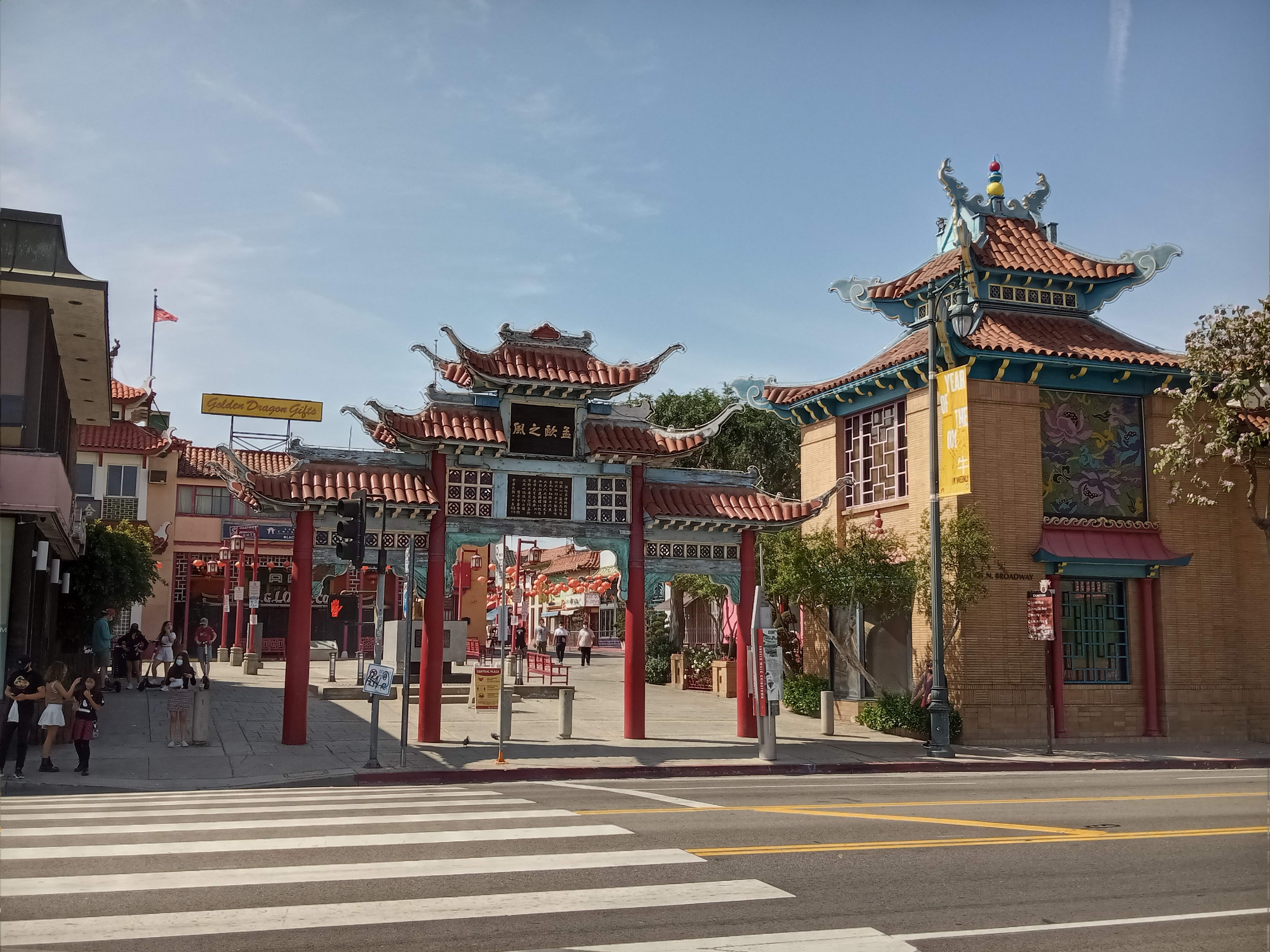
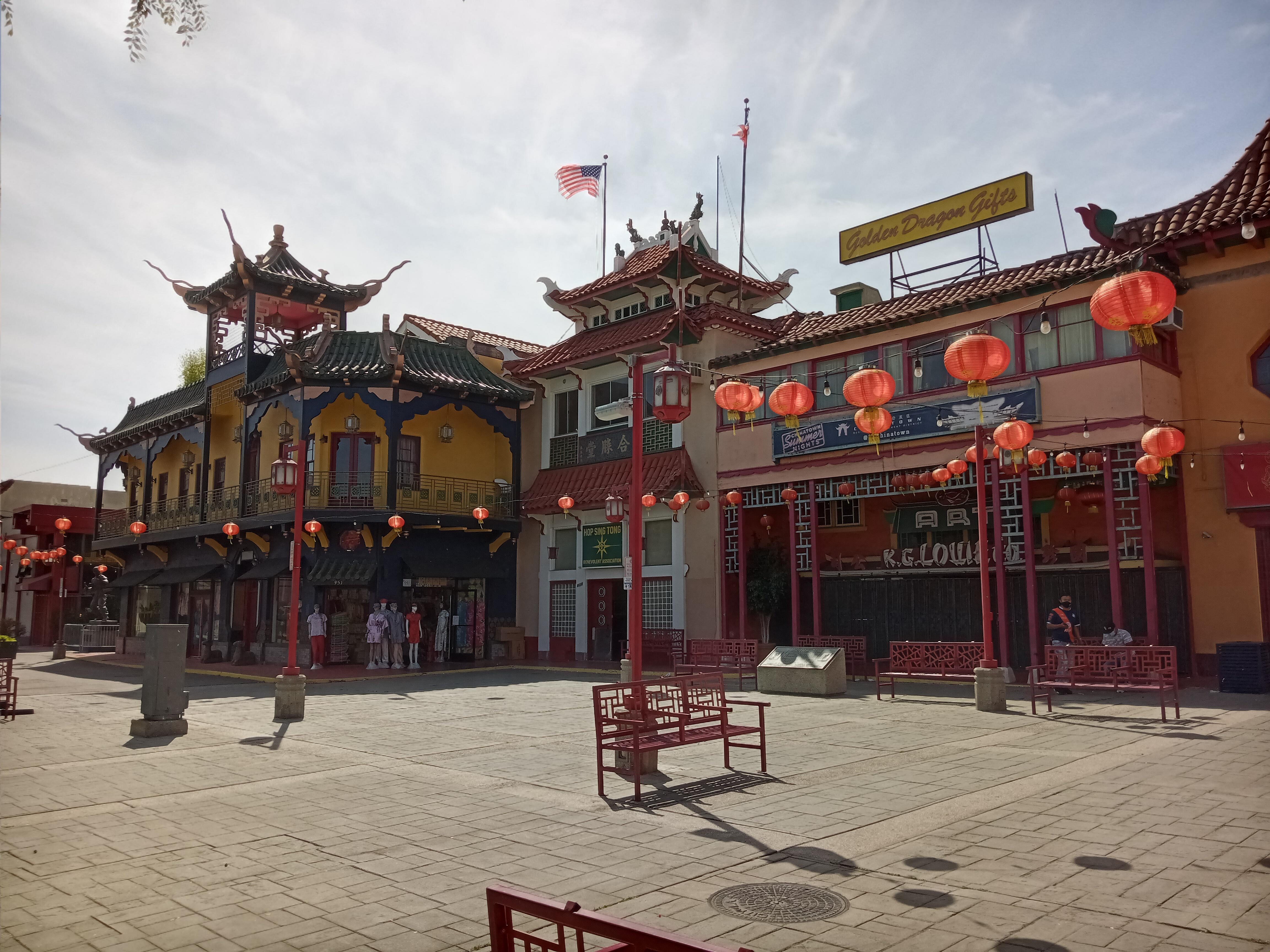
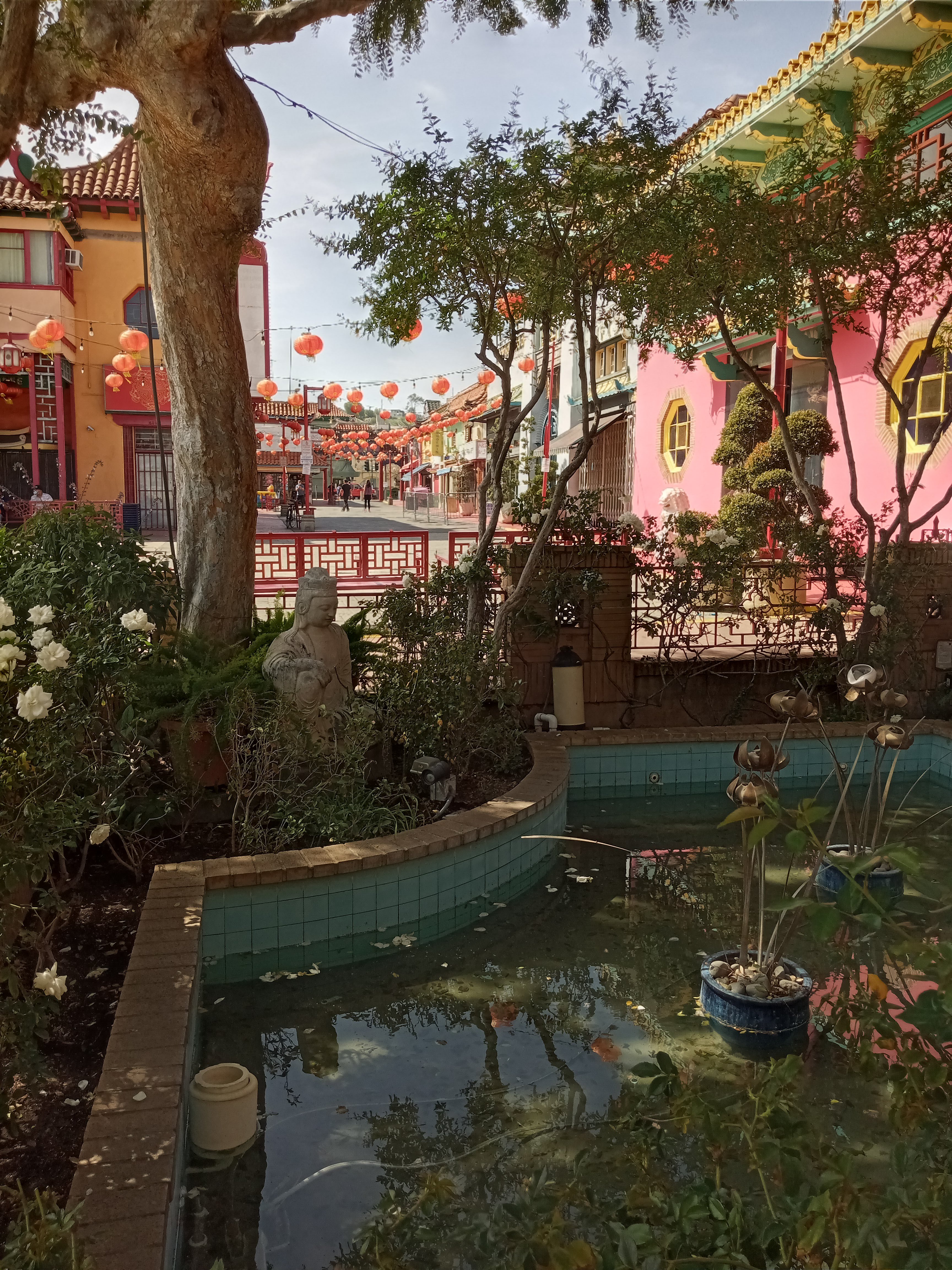
The entrance to the plaza, just past the elaborate wooden gateway, is graced with a statue of Sun Yat-sen, the first leader of the Republic of China following the 1911 Chinese Revolution, sitting atop a throne. Around the plaza you might notice the “blue sky, white sun, red earth” flags of the Republic of China, which was the national flag of China at the time the plaza was constructed, prior to the Chinese Communist Revolution of the late 1940s. Just to the left and down the alley is a larger-than-life statue of Bruce Lee in fighting stance, a popular selfie spot for martial arts fans.
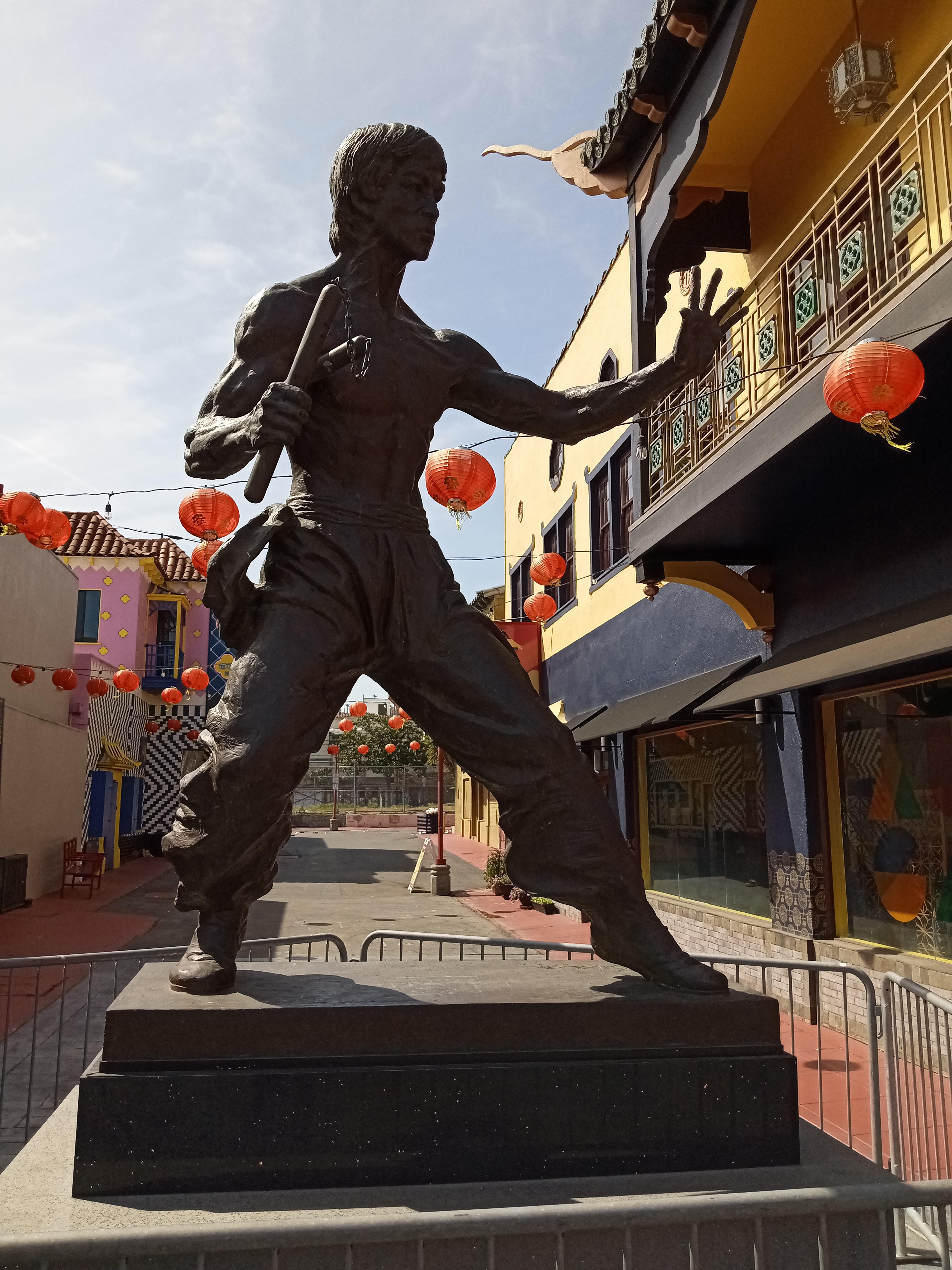
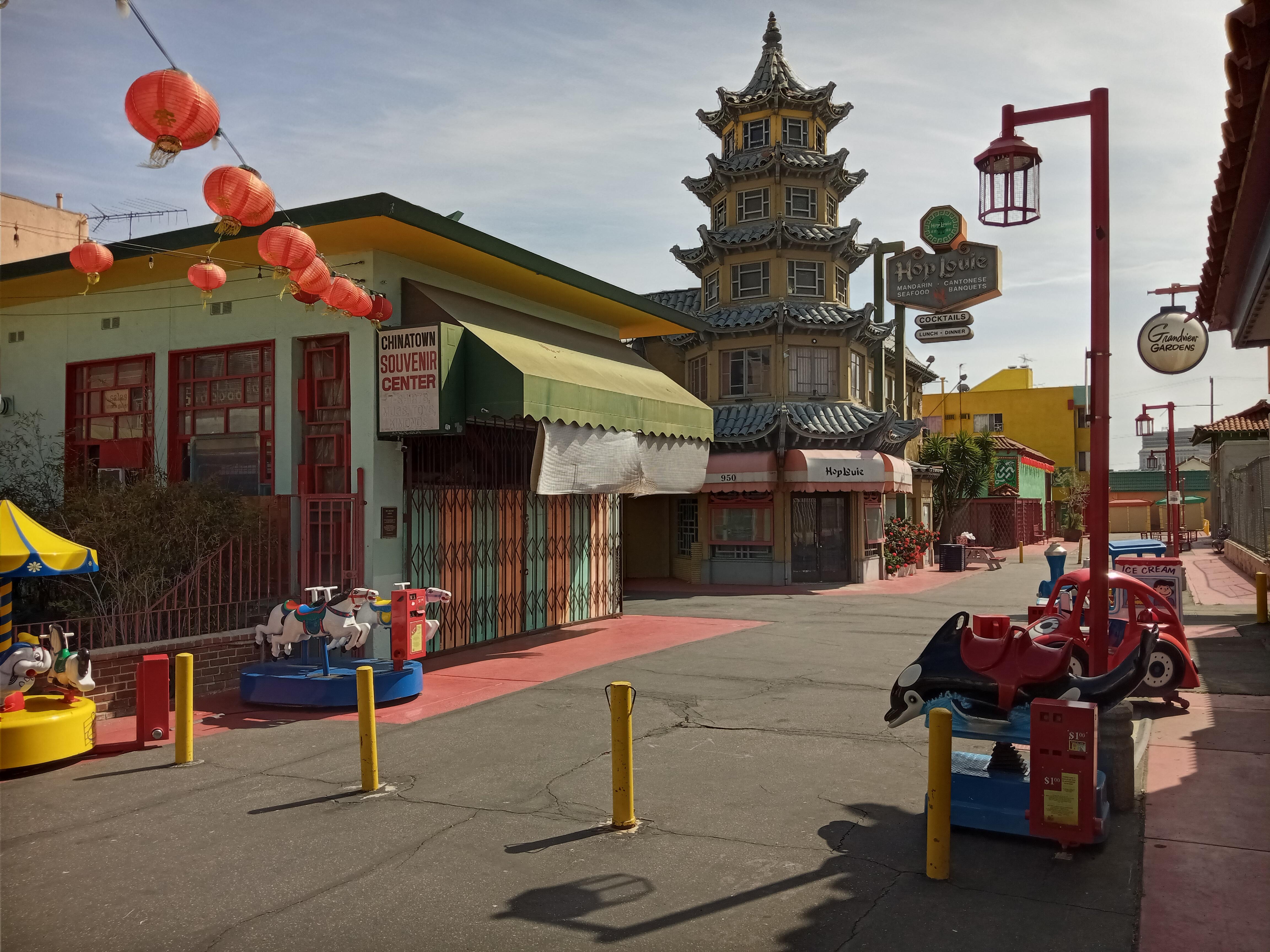

Spend some time exploring the plaza, admiring the colorful architecture and browsing the souvenir stores. And be sure to check out the elaborate wishing well, situated in the middle next to all the kiddie rides. When you’re done, exit out the west gate onto Hill Street and cross the road.
3: Chung King Road
Chung King Road is essentially the western extension of Chinatown Central Plaza, sitting across Hill Street from the plaza proper and with more hanging lanterns, Chinese architecture, and colorful murals. But where the plaza is typified by gift shops and souvenir stores, Chung King Road is dominated by art galleries and antique shops. As you pass the little plaza surrounding a tranquil fountain, you’ll find the quiet pedestrian alleyway running along the back. Apartments sit above the art galleries and antique stores that line the alley. Various artistic endeavors occasionally make their presence known on the street, such as the little tie-dye business that has cropped up recently, where you can bring your own clothes and have them dyed for a small fee.
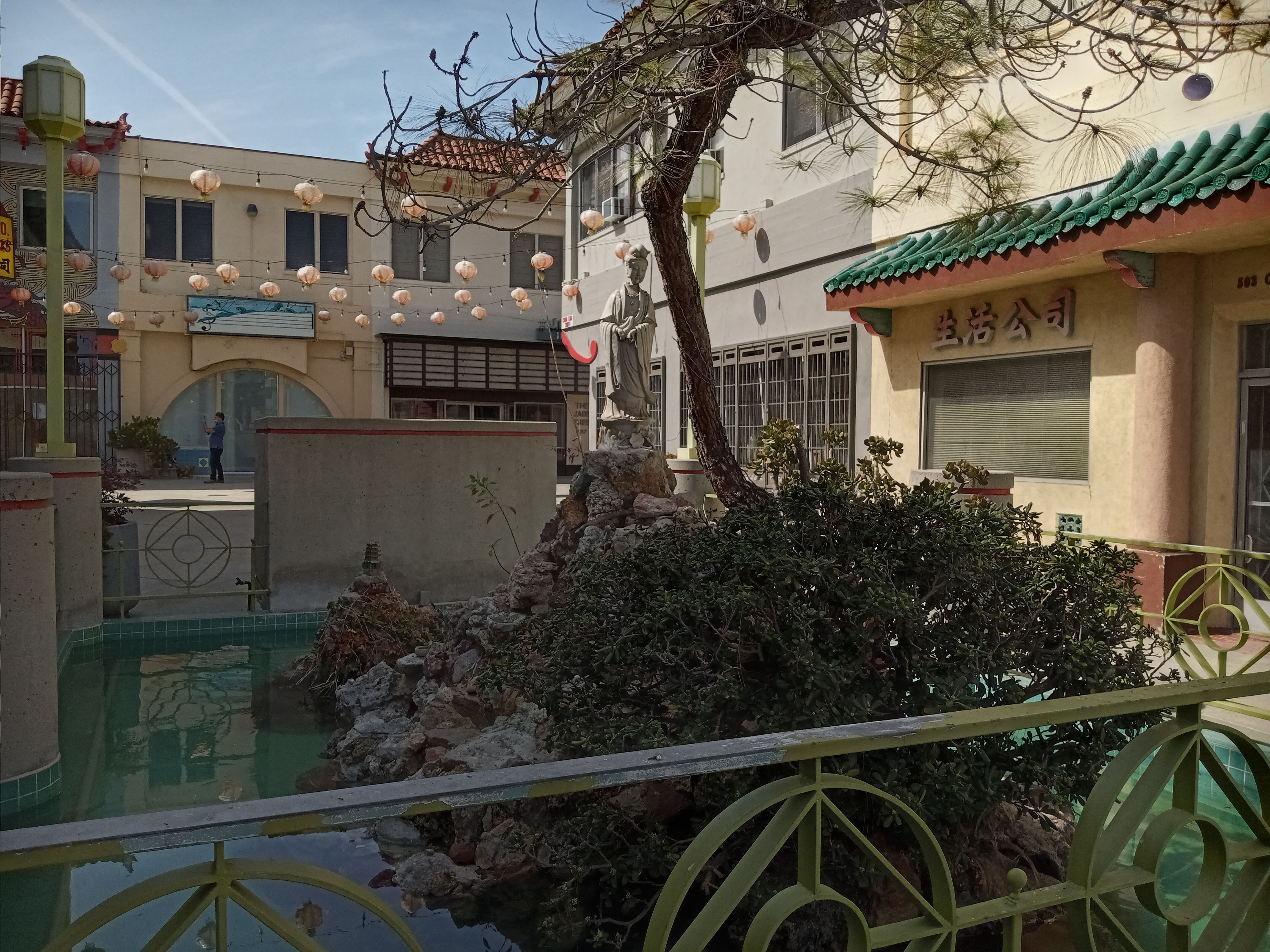

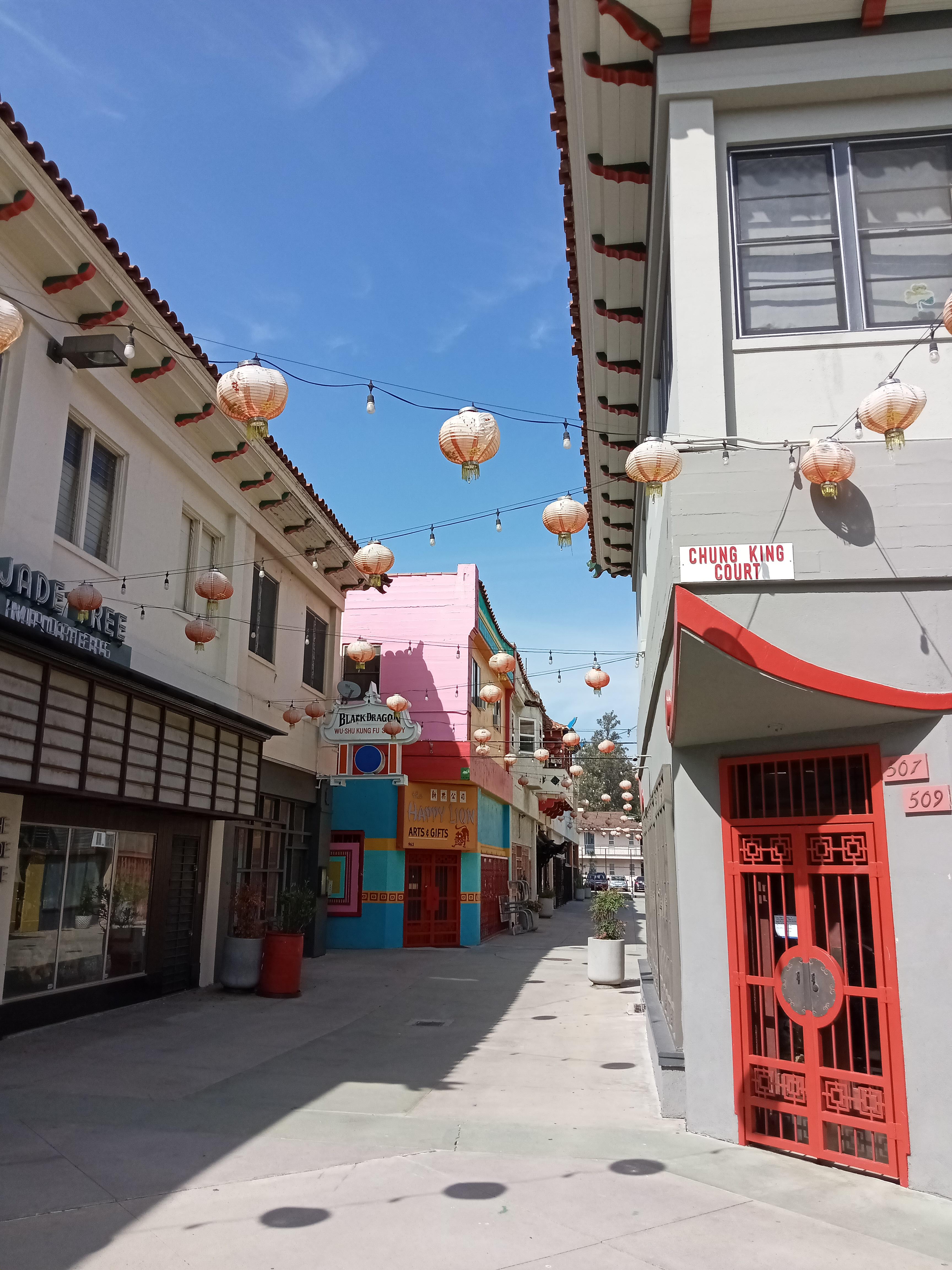
Cross back across Hill and make a left, walking up Hill to Bernard Street, then make a right.
4: Chinese Historical Society
At 411 and 415 Bernard Street are a pair of cute Victorian houses dating back to the 1880s, making them some of the oldest buildings still standing in Chinatown. Today, they house the headquarters of the Chinese Historical Society of Southern California, which maintains a little museum on the history of Chinatown. Inside are displays of artifacts from the original Chinatown, as well as a research center and library and a small bookshop. The center is open to the public on Sundays 2-6pm.

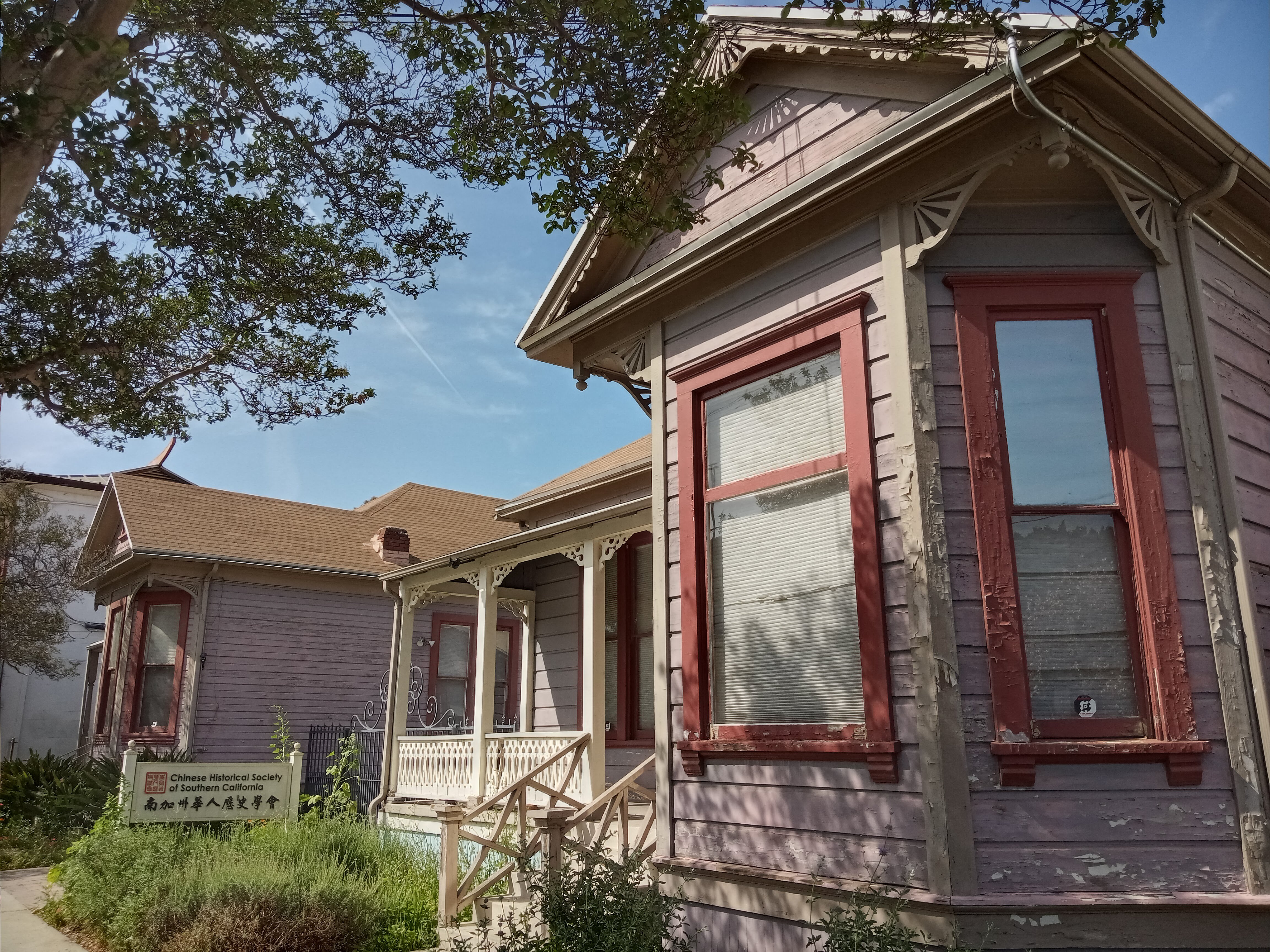
Continue along Bernard to Broadway, make a right, and start making your way back towards Chinatown Central Plaza. On the way, you’ll pass…
5: Phoenix Bakery
Perhaps the most beloved business in the neighborhood, Phoenix Bakery dates back to the creation of “New Chinatown,” opening its first store in Chinatown Central Plaza the year it was completed in 1938 before moving to its current location a block north in the 1970s. As such a mainstay of the community, it has become a local tradition to savor their cakes and pastries for special events. The almond cookies, watermelon pastries, and strawberry cakes are among the favorites, but it’s all delicious. Pop in and take your pick.

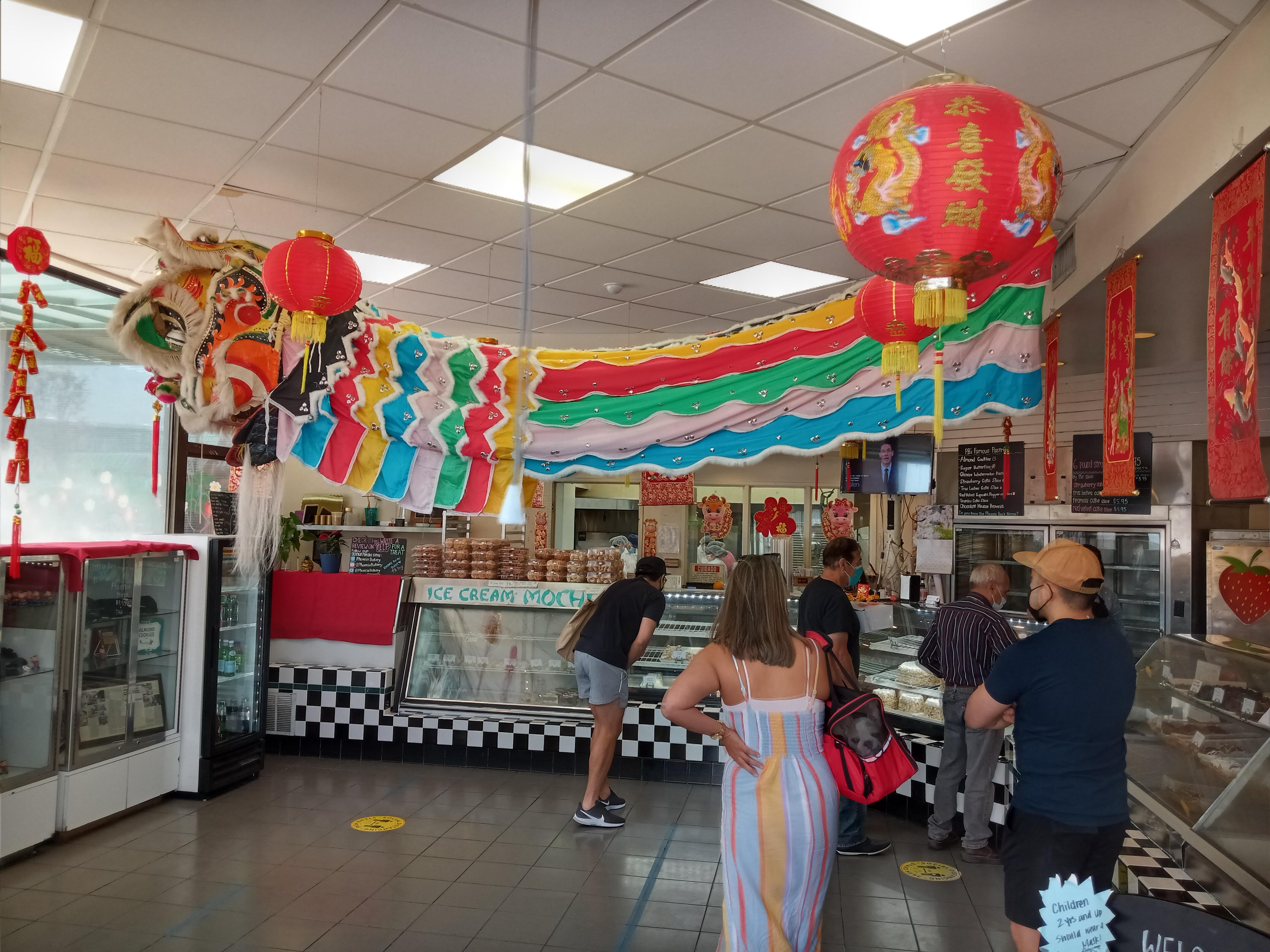
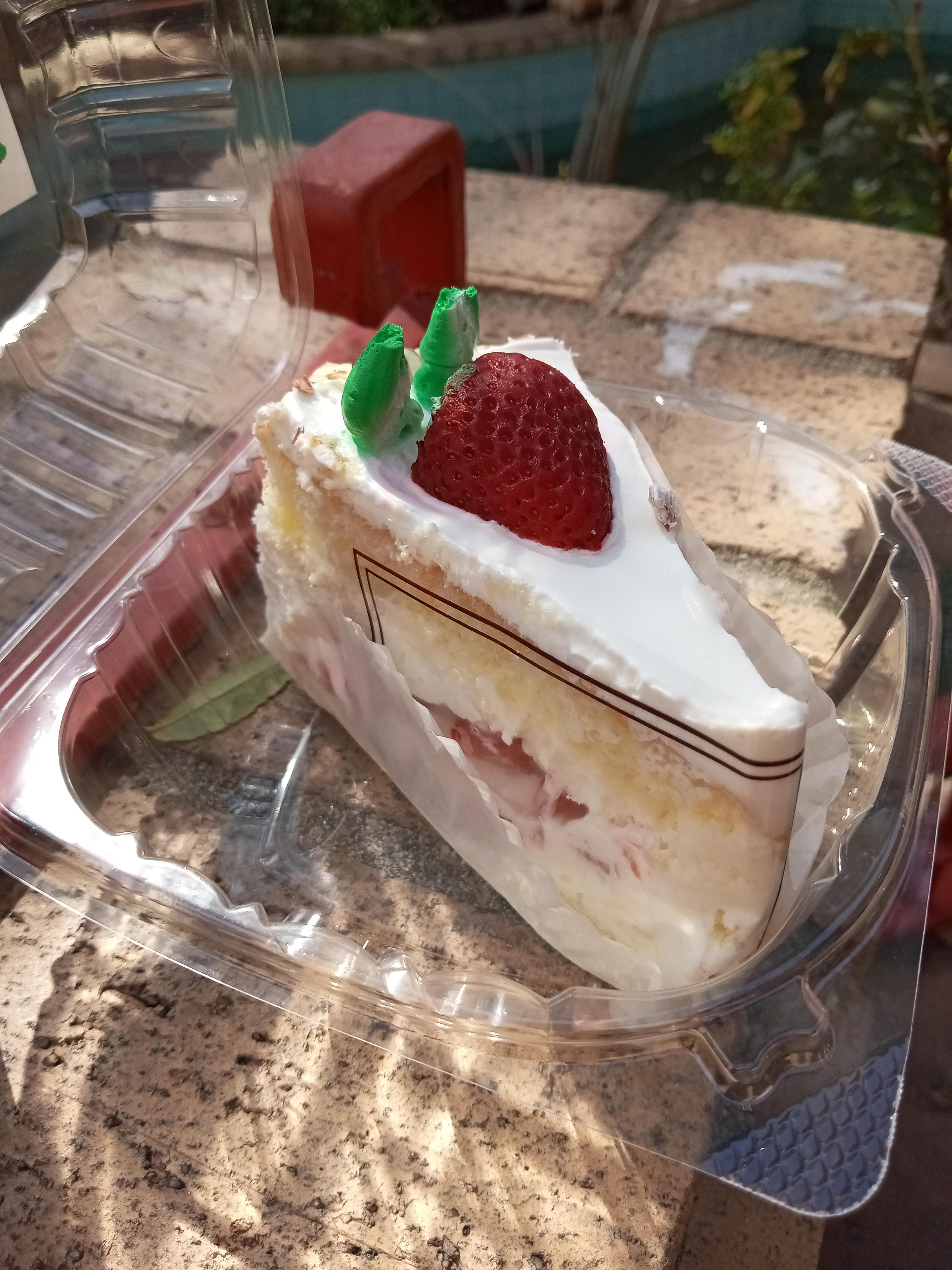
Continue down Broadway, past the Chinatown Central Plaza and Blossom Plaza. When you reach College Street, cross to the other side of Broadway and continue south until you reach the bustling vendor market with all the colorful umbrellas.
6: Saigon Plaza
Particularly along this stretch of Broadway, many shops spill out onto the sidewalk, selling tchotchkes, clothing, souvenirs, umbrellas, plants, even tiny fountains. But Saigon Plaza—along with the attached Dynasty Center—is the heart of Chinatown’s vendor community. Weekends are the busiest times, when the open-air aisles of the center can get really packed and bustling beneath the tarp roofs flapping overhead. Inside, you’ll find stalls selling cheap clothing, cell phone accessories, toys, and household goods. Wander through the back, where Saigon Plaza merges into Dynasty Center, and take the stairs down to Spring Street, where you’ll find a large nursery shop with rows of lush plants between tiny burbling fountains and garden statues.
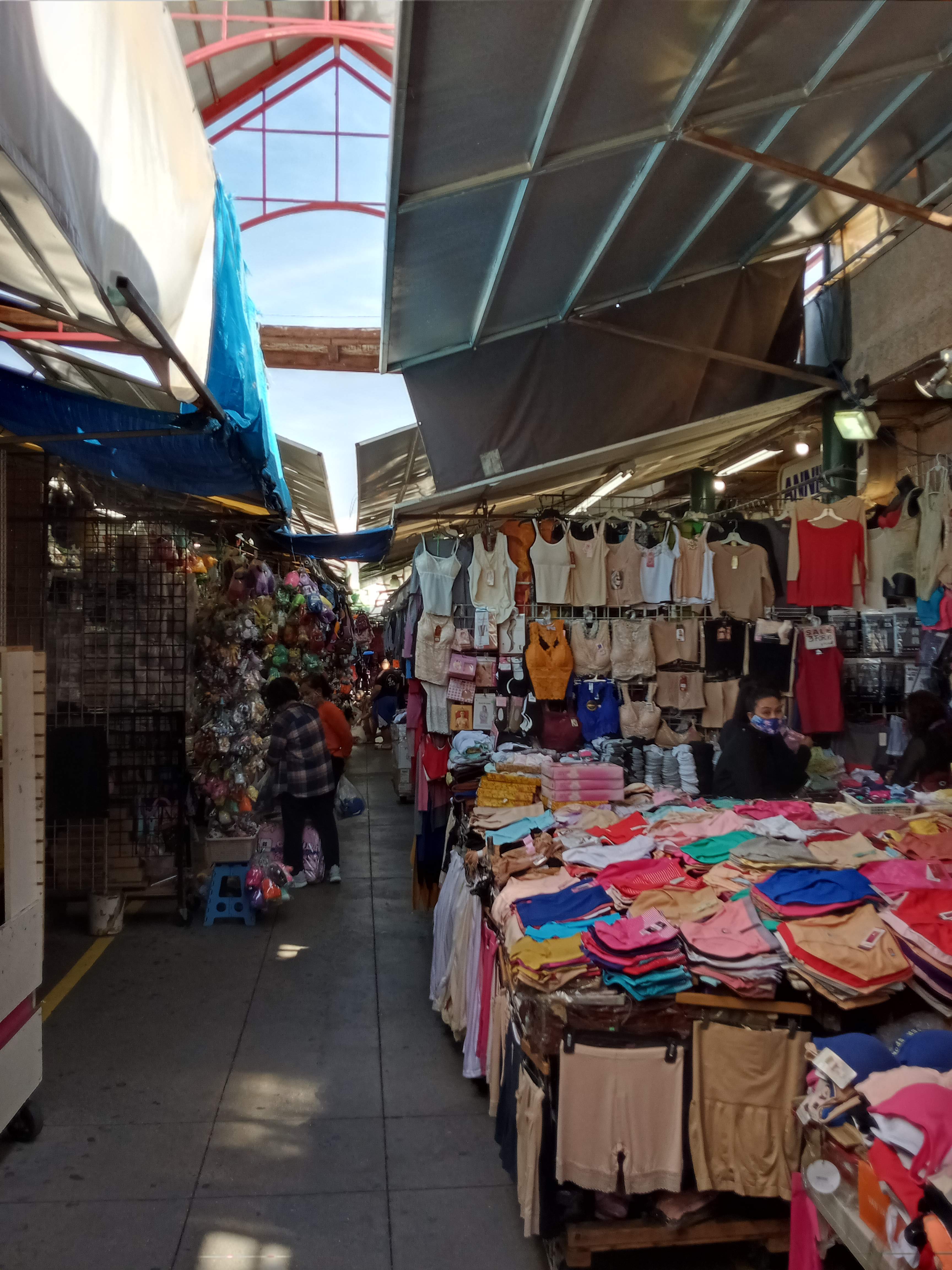


Continue around the block to Alpine Street and make a right, heading up Alpine Street past the various parking lots and banks that line this stretch of street. At the corner of New High Street, you’ll pass Won Kok Restaurant, a very popular dim sum eatery that frequently sees long lines around the building. After walking along Alpine for three blocks, you’ll enter the relatively quiet residential area of Chinatown. Make a left onto Yale Street.
7: Thien Hau Temple
Of Chinatown’s three temples, this one is the largest and most elaborate. Built in 2005, this Taoist temple owes its existence to a local group of devout Vietnamese refugees primarily from the Ca Mau province, on the southern tip of Vietnam. Fishing is a huge part of life in Ca Mau, so it’s fitting that the temple is dedicated to Mazu, the Taoist goddess of the sea and patron saint to fishermen.

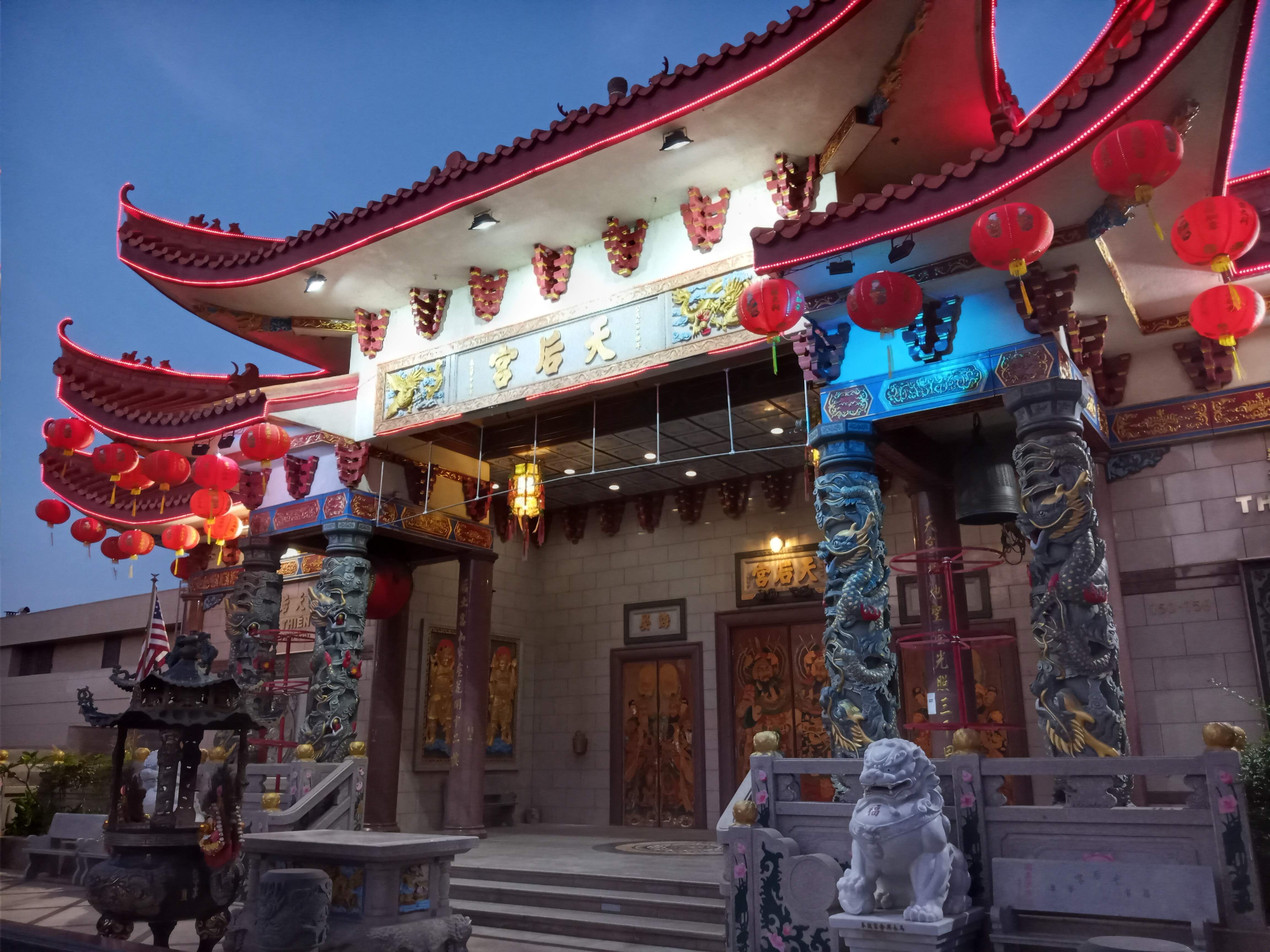

If you get a chance to peek inside during opening hours, it’s worth it to gaze at the shrines and admire the intricate decorations on the columns or the dozens of lanterns hanging from the ceiling inside. But the best time to come is definitely on the eve of Lunar New Year, when hundreds attend the new year ceremony to give blessings and make offerings to the deities represented by the shrines. The temple will be jammed pack with people and thick with the smoke of thousands of incense sticks, and as midnight draws near, lion dancers and local schoolchildren perform on the street out front before firecrackers are set off. It’s loud, claustrophobic, and an absolutely glorious sight to behold.
8: Ord and Yale Street Park
Down the block from the temple, where Yale curves into Ord Street, a brand new park has been built on the steep slope behind the local branch of the public library. It’s made up of a series of concrete terraces linked by stairways and ramps. In the little plaza at the front, a small waterfall cascades down a rock garden, while tucked in the back is a playground and a few sheltered picnic tables, with restrooms and exercise equipment. Don’t be intimidated by the fences and the keypads on the gates; when we visited, we found that the two gates facing the stairway were unlocked, even if the main gate under the ‘welcome’ arch was locked.



The centerpiece of the park is a long, brightly painted stairway linking to the street and apartment buildings atop the hill. At 147 steps, it’s a steep climb but you’ll be rewarded with an excellent view over all of Chinatown. From the top, you can look out towards the mountains, watch the bustle of the neighborhood below, or spot trains pulling into Union Station.
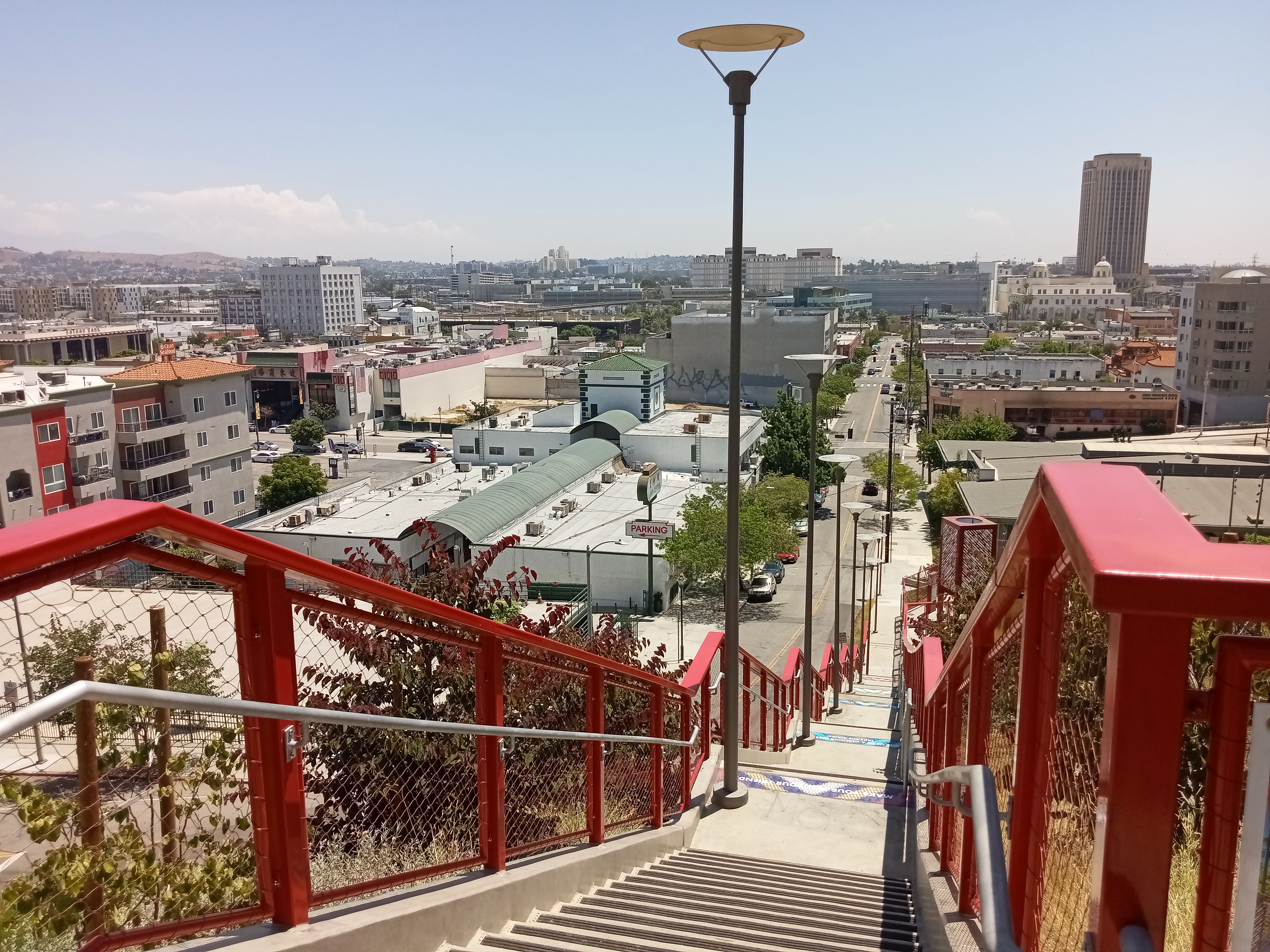
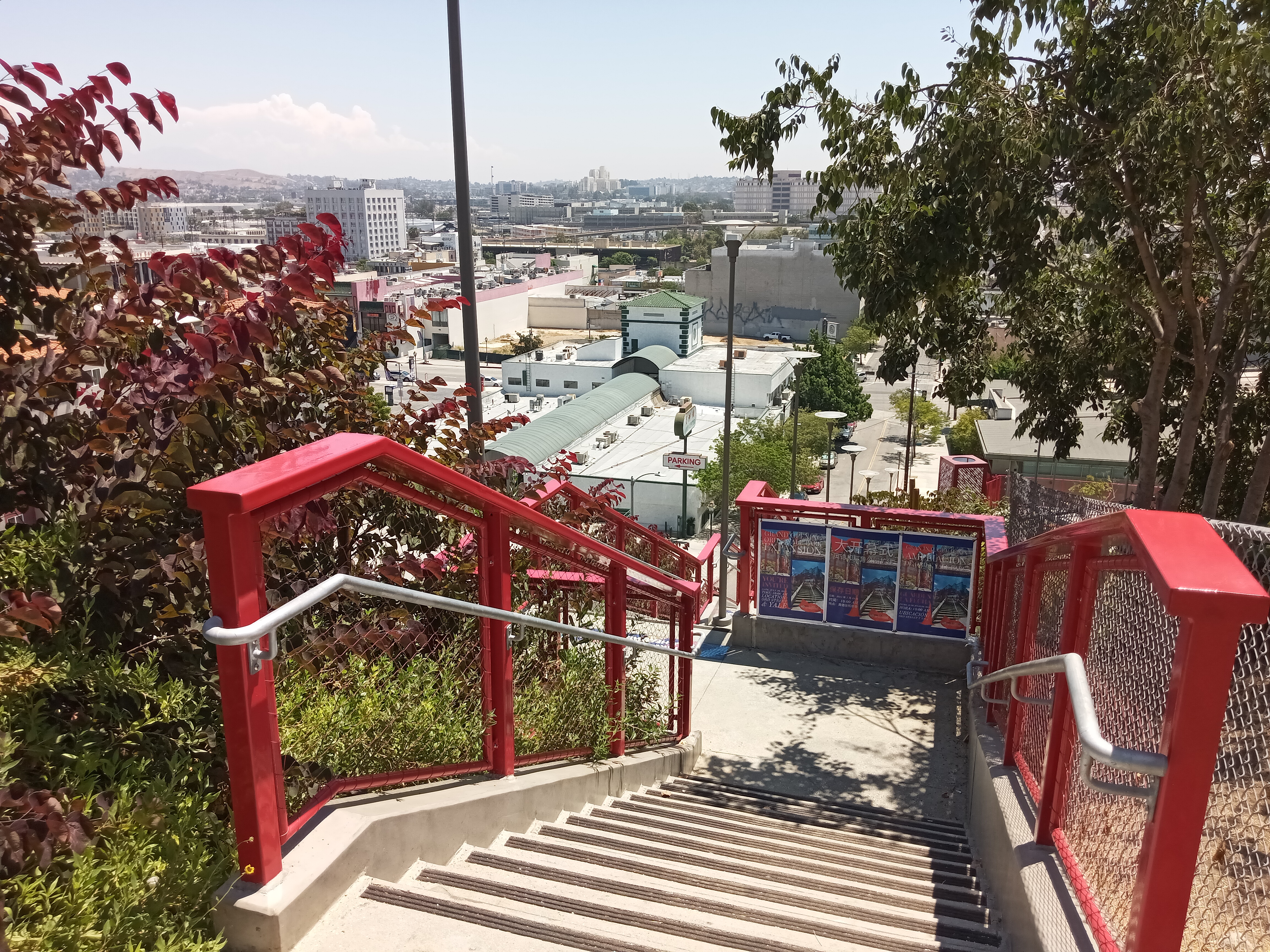
Continue down Ord to Hill Street, cross the street and turn left up Hill. You’ll pass an empty lot adorned with an old sign sporting a dapper turtle wearing a top hat and monocle. This was once the site of the Velvet Turtle restaurant, and since it was demolished the site has been the subject of a lot of development speculation, but nothing seems to have come of it so far.
9: Far East Plaza
Prior to the pandemic, this little two-story mall spanning the block between Hill and Broadway was a major foodie destination. Starting with Roy Choi’s Chego (which closed a couple years ago), suddenly seemingly every up-and-coming chef was opening a place in Far East Plaza. The most notable was Howlin’ Rays, which was arguably the most popular restaurant in all of Los Angeles, where the lines were typically three hours long for their amazing hot chicken sandwiches.



Things got really quiet in Far East during the pandemic, with many of the trendy restaurants closing outright, but business has picked back up recently. After operating on a delivery-only basis for two years, Howlin’ Rays is back to offering walk-up takeout orders. A couple of old standbys are hanging in there, like noodle shop Kim Chuy and the popular pho restaurant Thien Huong, both of which sit near the entrance on the Broadway side. New places are opening in the shops vacated by the closed restaurants, so this mall is quickly reclaiming its status as a foodie destination.
Head all the way through the mall to Broadway, then make a right and continue down the street. You’ll pass through the busy intersection of Broadway and Ord, which has lots of produce and merchant stands spilling out onto the sidewalk. Continue on for another block and on your right you’ll suddenly come across another temple.
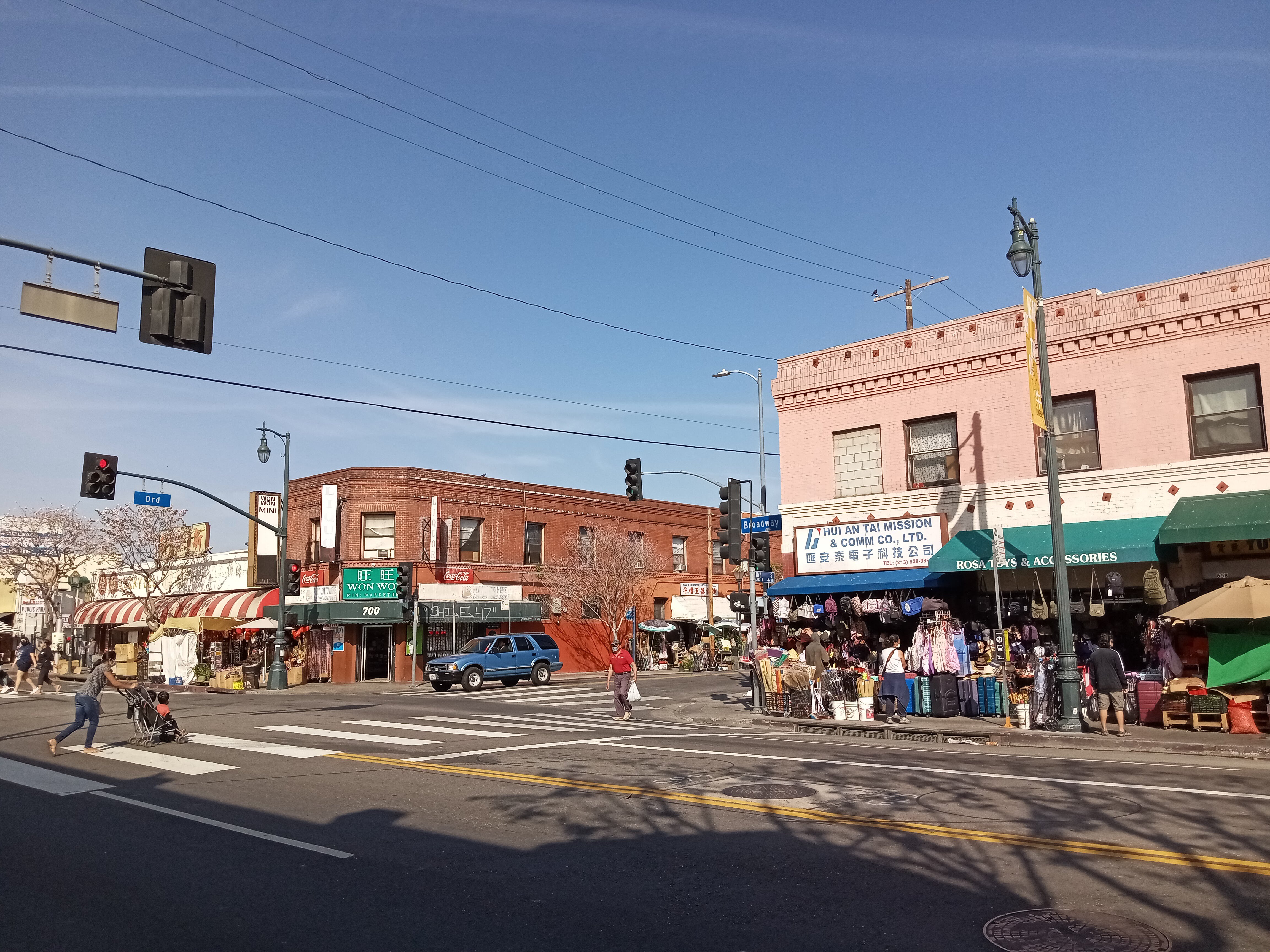
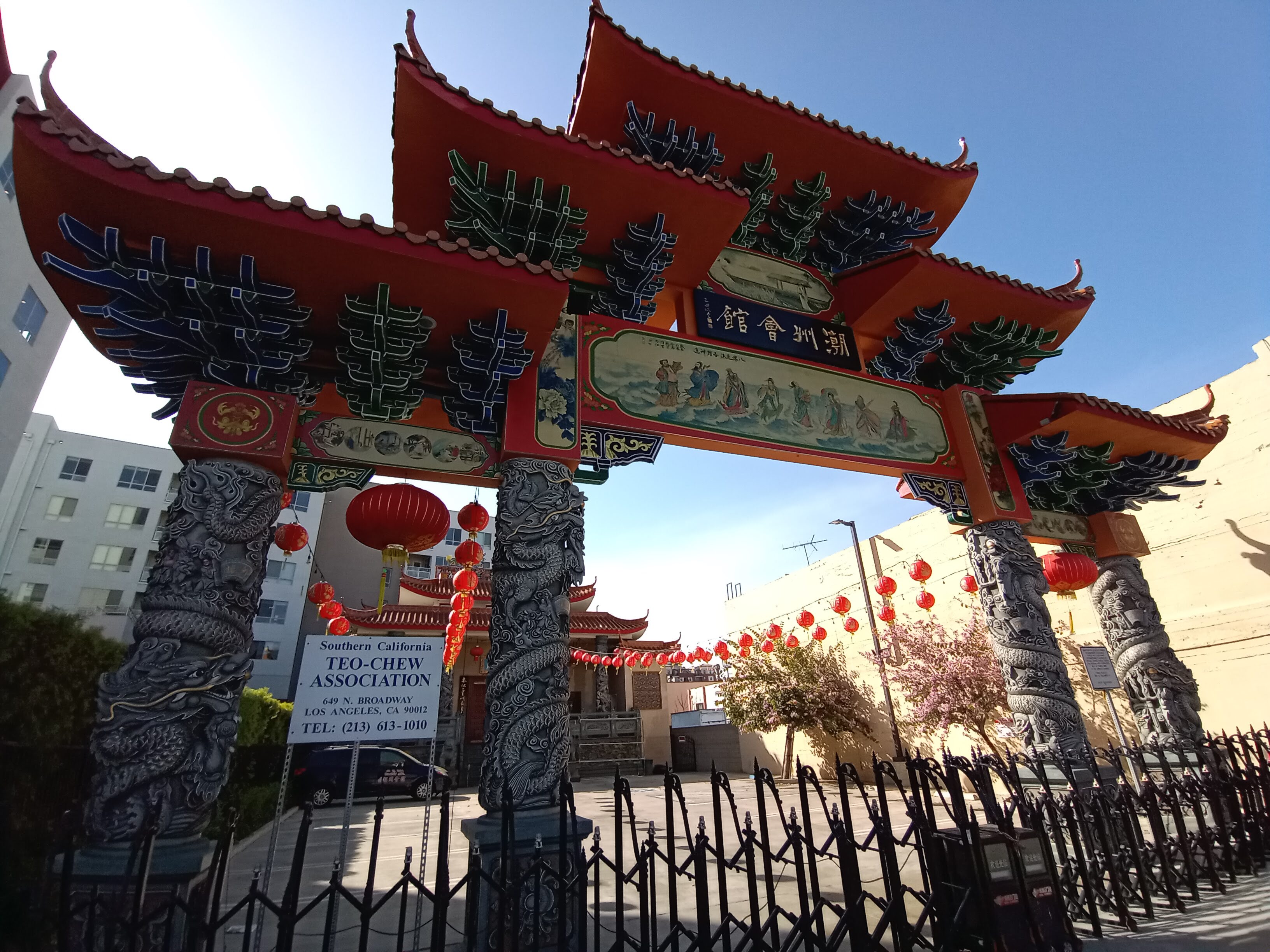

10: Teo Chew Temple
This beautiful and ornate Buddhist temple is run by the Teo-Chew Association of Southern California. The Teochew are an ethnic Chinese group native to the Guangdong region of South China, although many of the Teochew who came to Southern California immigrated from Vietnam, Cambodia, and Thailand. The temple is small but really beautiful, with an elaborate gate and façade facing Broadway, with stone lions guarding the temple and columns adorned with intricately carved dragons. Inside, you’ll find a set of small Buddhist shrines. There’s not a lot of information provided in English (even the website is mostly in Chinese), but it’s still worth a look.
11: Chinatown Gate
Just a little further down Broadway from the temple is the iconic Chinatown gateway, featuring two golden dragons perched above the street, both regarding a glowing orb (representing a pearl) set in the center between them. Always eye-catching, by day the very expressive dragons look pretty goofy, but at night, with their eyes glowing brightly, they look considerably more intimidating.
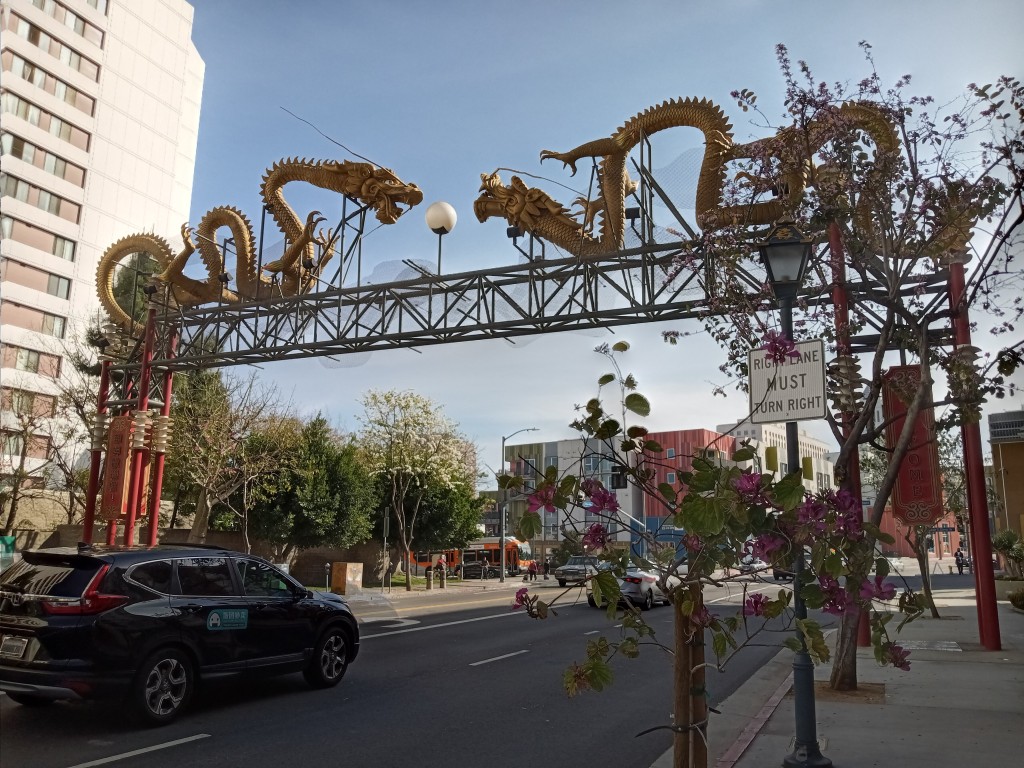
Backtrack on Broadway to Ord Street, then make a right and start heading downhill. This stretch of Ord has a lot of good places to eat. Right near the corner of Broadway is My Dung Sandwich Shop, a beloved bahn mi place, while on the next block is The Little Jewel of New Orleans, a small grocer selling Louisiana products (including plenty of Cajun and Creole ingredients) with a deli in the back that makes excellent po’boys. But the most famous restaurant along this street is found at the end of Ord at the bottom of the hill, on the corner with Alameda.
12: Philippe the Original
One of the oldest continuously-running restaurants in Los Angeles, Philippe has been in business since 1908 and has sat in its current location since 1951. It’s most well-known for its French dip sandwiches (deli sandwiches dipped in au jus), which it claims to have invented, an achievement also claimed by the equally old Cole’s in Downtown. Inside, you’ll find a classic deli counter, sawdust floors, and lots of seating both upstairs and down. The servers are all very friendly and prepare your whole meal when you order, as well as handle your payment before you take your food tray and find a place to sit.
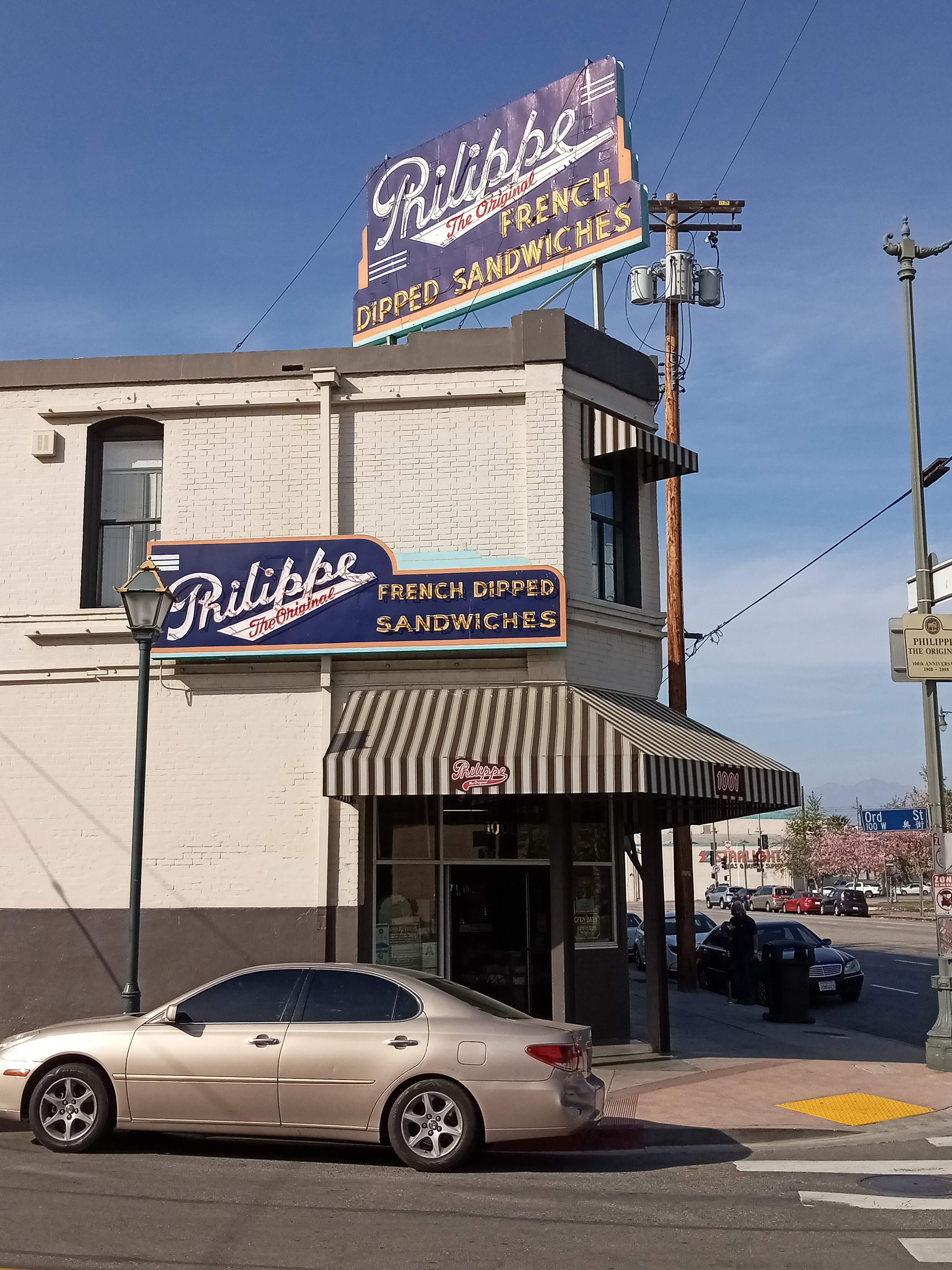
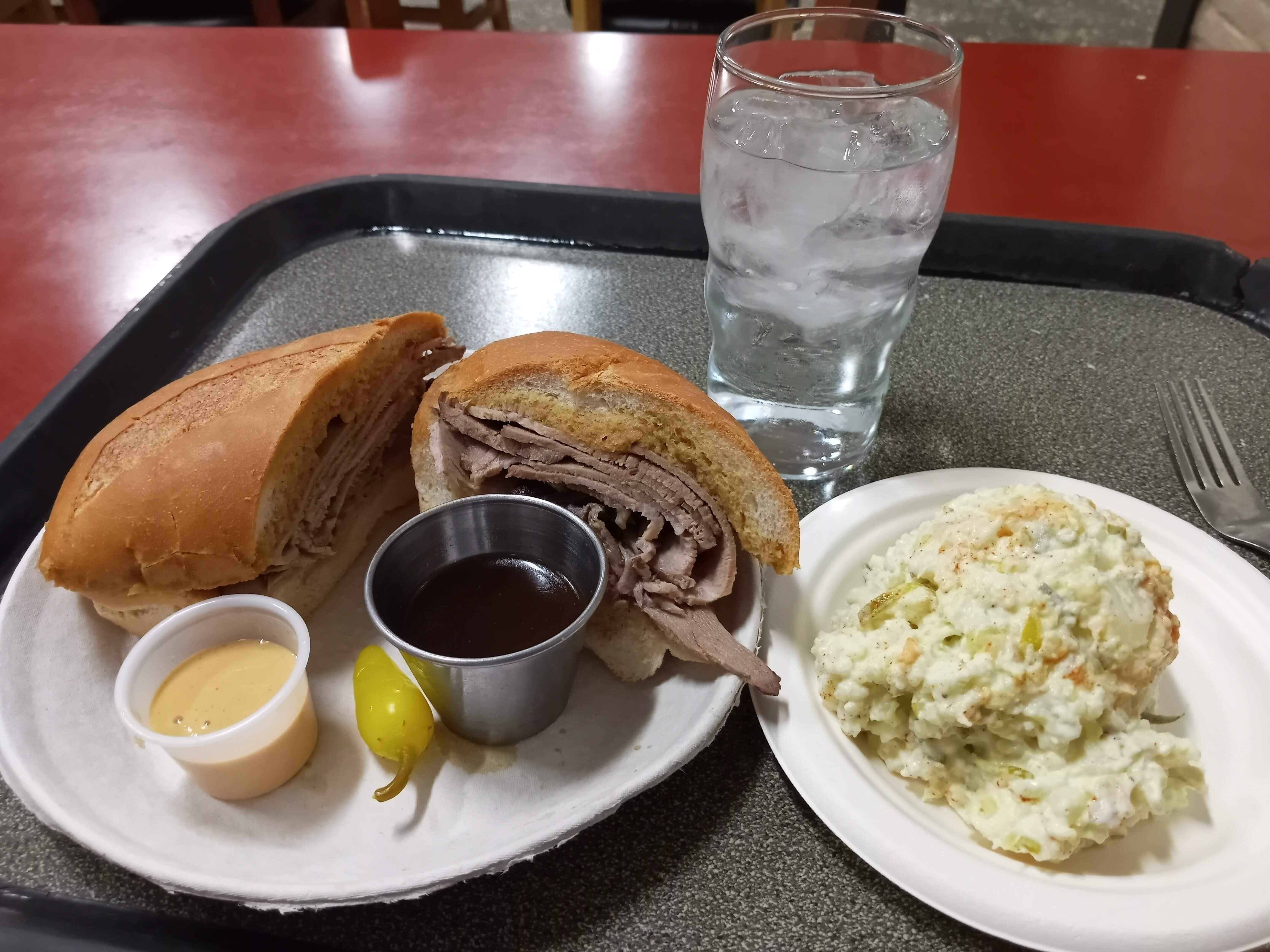

The sandwiches are fantastic, served with au jus for dipping and a cup of house mustard (which is so spicy it tastes almost like horseradish). But it’s really the atmosphere and the history that you come here for. There’s tons of fun decor, like old phone booths, neon beer signs, and a candy counter, and railroad enthusiasts will enjoy the train museum in the room in the back by the restrooms, which has lots of little model trains and old railroad memorabilia, including a collection of circus train posters.
This concludes the Chinatown tour, but if you want to continue, Olvera Street and Union Station sit just a couple blocks south off Alameda. Just past Olvera Street and the Plaza is the only surviving building from the original Chinatown, now home to the Chinese American Museum. Across Alameda, Union Station sits on the site of Old Chinatown and has a couple of monuments to commemorate this fact: one is a plaque in the Metropolitan Water District courtyard that marks the boundary of the old neighborhood, while the other is a fountain that contains artifacts from Old Chinatown that were excavated while they were building the subway. You can find more information on these, and everything else Union Station has to offer, in our post on Union Station.

Wonderful article!!! Thanks for writing this well detailed description about all the places in Chinatown 🤗♥️
LikeLiked by 1 person
Thank you! ♥️
LikeLike